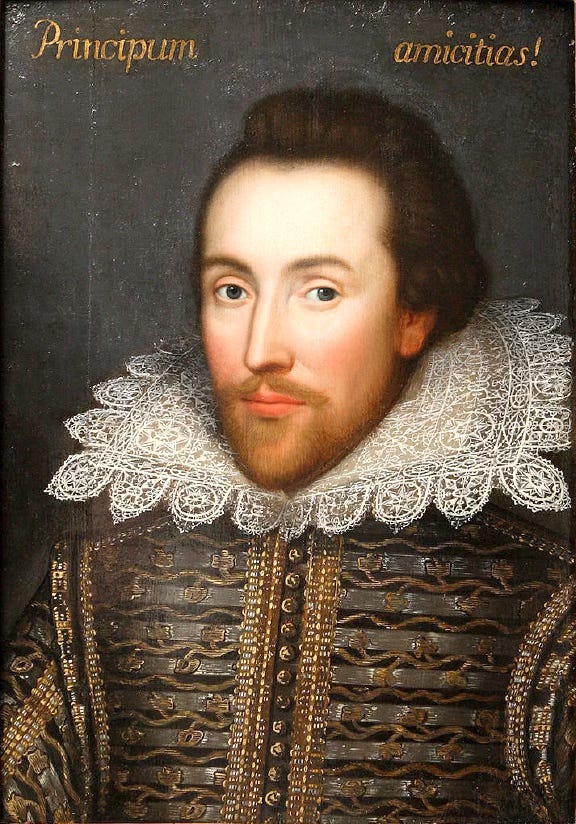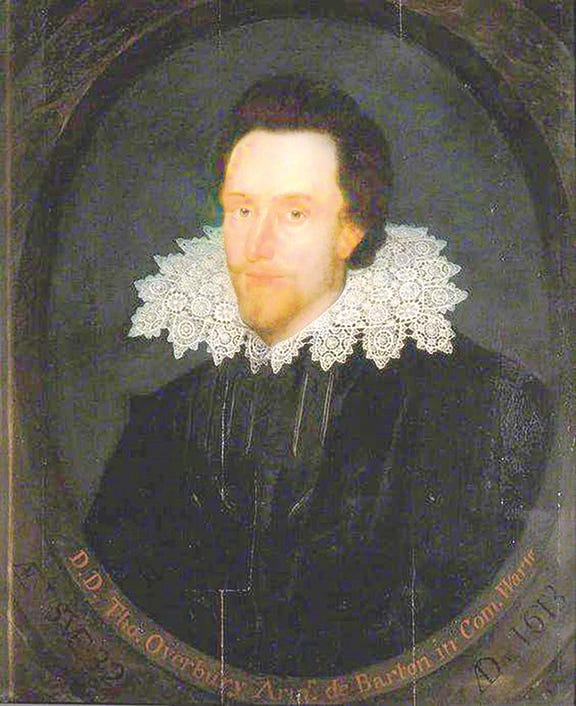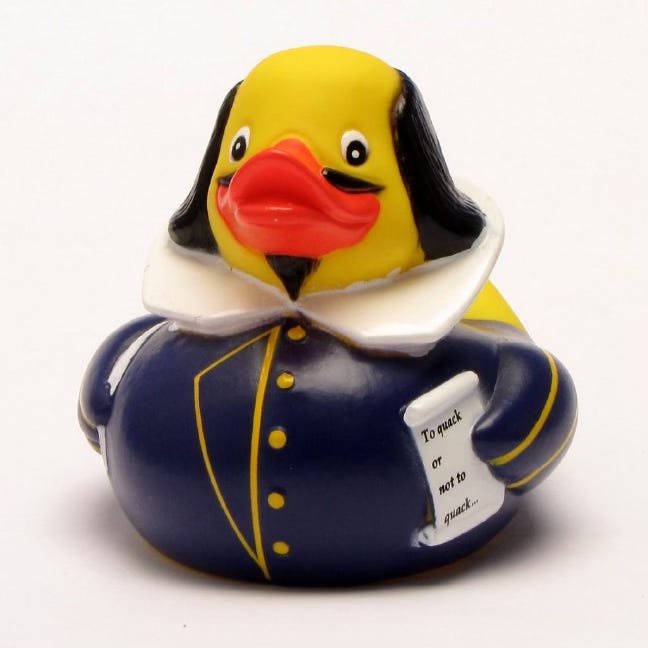I was recently “going through my papers” (as writers are prone to saying) to collect all the various pieces I have written on the subject of the authorship question when I came across this short article from May 2015. Although I had submitted it for publication, it was rejected at the time and has sat on my computer since then, unread and unloved. While it is very much “of its time” in the sense that it refers to a specific contemporary publication, it does deal with a perennial matter—the discovery of (yet another) portrait of Shakespeare. Every five to seven years it seems the media go into a frenzy—for a day at least—when someone claims to have discovered a previously unknown portrait of Shakespeare. With the exception of the Cobbe Portrait (which I discuss in the article), these discoveries fade away almost immediately and are forgotten forever. I approach this issue with my tongue firmly in cheek in this piece, but I hope you will agree that the points raised are pertinent and, I hope, also have some foundation in truth. I hope you enjoy this short piece from more than eight years ago. Here’s to the next portrait to be discovered—one is certainly due!
May 2015: A lot of hot air has been expended this last week around a “newly discovered” portrait of William Shakespeare. This revelation appeared in Country Life magazine, and the editors knew it would be big news. The image appeared on the cover under the heading, “Shakespeare: his true likeness at last,” and lower down, “The greatest discovery in 400 years.” Indeed.
Much hot air followed on the BBC and other media outlets, the obvious weakness of the case lost in the apparent euphoria of finding that Shakespeare was in reality not a weird-looking bald man with one eye higher than the other, but rather quite a looker. In fact, he looks not unlike the bearded hipsters walking along most city streets. But, of course, it will surprise no one to find out that the picture is, unarguably, NOT Shakespeare. Let me allow the brilliant Dr. Ros Barber explain:
“The engraving on the frontispiece of John Gerard’s The Herbal or General History of Plants [first published in 1597] is a representation of Dioscorides, a Greek doctor from the time of the Roman emperor Nero. Dioscorides’ book on herbal medicine had been the standard text on the subject for 1,500 years. In other words, he was considered something of an authority on the subject of the book and was depicted there to give it his seal of approval. For being the top writer in his subject, he gets a laurel wreath on his head. The Roman army toga is a bit of a clue, for Dioscorides was a physician in the Roman army. Why Shakespeare would be depicted in a toga is anyone’s guess. Yes of course, this is how an Elizabethan actor might have been dressed in a Roman play. But we have no evidence that Shakespeare was ever seen on stage in a toga, and since many other actors were seen in togas, this would hardly identify him as Shakespeare. If you want to do that, at least put a quill in his hand. We can be sure that the picture is meant to be Dioscorides because when the book was updated and reprinted in 1633, his name was helpfully labelled. You can compare the two images for yourself: same facial hair, same toga, same footwear—and on a plinth that says ‘Dioscorides.’ Just in case someone thought he was Shakespeare, or Francis Drake, or someone else with a fancy moustache.” (Please visit my site for a much longer analysis: RosBarber.com.)
Thank you, Ros. That this should be the case could not have come as any surprise to readers of Country Life, as the final headline on the cover reveals: “How one man cracked the Tudor code.” Oh, I see—there is a code . . . .
Scholars are naturally highly skeptical, and so they should be. But perhaps that is besides the point. It does not matter that the picture is not of Shakespeare as far as Country Life (and the BBC and the many newspapers that ran the story) is concerned—they have sold far more copies of their magazine than they usually do because of this “discovery” and are unconcerned if the evidence is flimsy or not. They have met their chief goal—raising their profile and making money. So if it turns out not to be Shakespeare—which it is not—what is the problem?
This is not unlike the case, mentioned by Ros Barber, of the last “newly discovered” picture of Shakespeare, the so-called Cobbe portrait which was identified as the Bard in 2009:
After a massive publicity campaign and traveling exhibition entitled, “Shakespeare Found: A Life Portrait,” the picture was (and still is) used to cover all advertising material and information for the Shakespeare Birthplace Trust in Stratford-upon-Avon.
This is the case despite the fact that the vast majority of scholars (with the exception of the then Chairman of the Trust, Professor Stanley Wells and its [ahem] Head of Knowledge and Research, Dr. Paul Edmondson) believe it to be a portrait of someone else entirely (Sir Thomas Overbury) and that the claims of it being Shakespeare are, at the very least, ridiculous.
But again, perhaps we are missing the point. As Professor Wells reported in his Chairman’s Introduction to the 2009 Annual Report and Summary Financial Statements of the Trustees and Guardians of Shakespeare’s Birthplace:
The discovery of the Cobbe portrait of Shakespeare . . . was an unprecedented opportunity for the Trust to publicise its work . . . worldwide media attention valued conservatively at £15 million followed the unveiling of the portrait in London and the subsequent exhibition at The Shakespeare Centre [in Stratford ]. And the portrait continues to “support the mission of the Birthplace.” Whether it is Shakespeare or not is irrelevant, as the driving force behind the promotion of both it and the Country Life portrait is not knowledge— it is something else entirely.
And so we come to the true and honest representation of Shakespeare, the only one which can claim to have true provenance since the engraving contained in the First Folio—the Shakespeare Rubber Duck.
No, it is not Shakespeare—though it is not “not Shakespeare” any less than the Cobbe or Country Life Shakespeares are not Shakespeare. But it is at least honest, and it is also useful. It is there in the Shakespeare Birthplace Trust shop to make money. It is there unashamedly to be sold. Furthermore, it can help us understand something about Shakespeare that the false portraits cannot. For it is a true embodiment of Shakespeare in our culture: it is a commodity, a memento, an accessible and “easy” interaction with Shakespeare. It is a product of the heritage industry that Shakespeare and the Birthplace Trust are part of. It is one of the primary ways in the present of relating oneself with Shakespeare, without having to take the trouble of reading all those old and difficult plays. It is a true representation of Shakespeare’s place in our culture—known, familiar, but only consumed in easy manifestations. We spend our money on it, but it openly reflects our need and our desire. The other portraits are lies; they reflect our needs and desires too, but dishonestly. Their promotion is the work of tricksters and misanthropists, turning us over and taking our money. Only the Shakespeare Rubber Duck is true. It is the real Shakespeare today. ~ ~ ~











That would be great. Please send to ShakespeareanAuthorshipTrust@gmail.com. Thanks
Thank you for your comment Umberto. I look forward to hearing more on Florio who is certainly becoming one of the leading alternative candidates for the works of Shakespeare. You and your Florio colleagues are very active now and it is great to be exposed to new research. I look forward to hearing more. I am sure you know Fabrice Collot who gave an excellent and thought provoking talk at last year's SAT/DVS conference. All power to you!